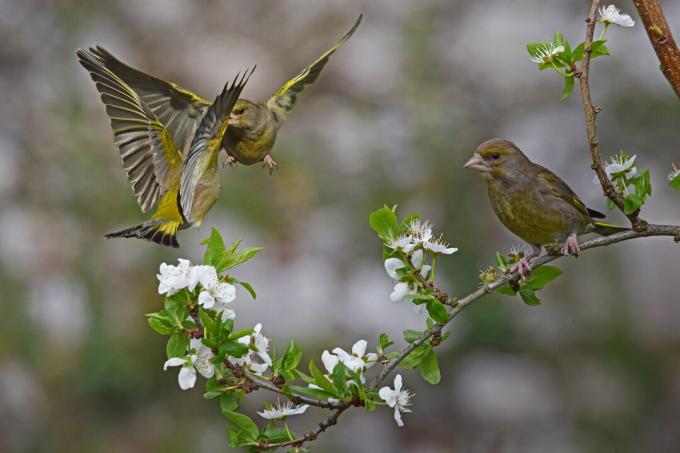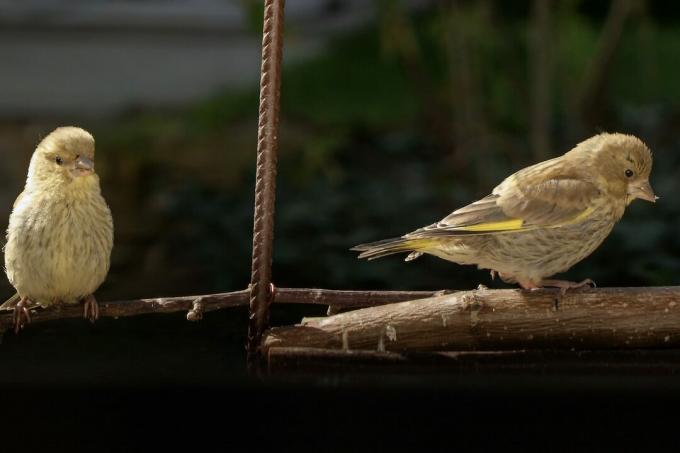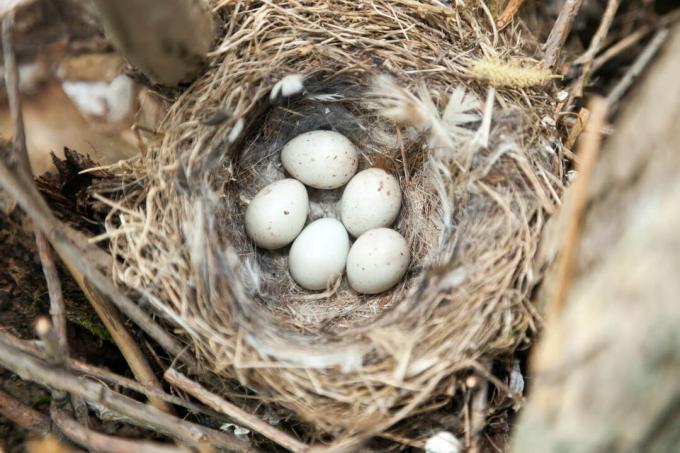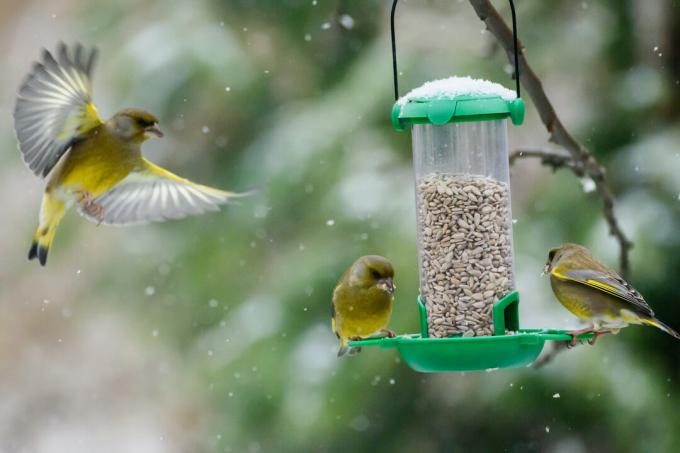How do you recognize the greenfinch? What does it feed on and how can it be supported additionally? We answer these and other questions in our large profile about the green finch.

The greenfinch (Chloris chloris or Carduelis chloris), also called greenling, is a songbird that is widespread throughout Europe. Here, too, he is a frequent guest in open landscapes, parks and gardens. With its beautiful green-yellow plumage, it is a real eye-catcher and easy to recognize even for the inexperienced bird watcher. However, the green finches had a very unfortunate year in 2009: a disease called trichomonadosis affected large parts of the population and caused around 80,000 animals to perish. Fortunately, the disease has been contained and stocks have since recovered well. Nevertheless, sick or dead animals should be reported to the NABU, along with feeding places and bird baths be cleaned regularly, otherwise they become a transmission point for infectious diseases can. You can find more interesting - and more enjoyable - information on the subject of greenfinches in our species portrait below.
contents
- Greenfinch: wanted poster
-
How do you recognize the greenfinch?
- How does the greenfinch singing sound like?
- What does the young greenfinch look like?
- How do you recognize the eggs of the greenfinches?
- How do female and male greenfinches differ?
- What is the bird's preferred habitat?
- Where does the greenfinch build its nest?
- When is the greenfinch's breeding season?
- What does the greenfinch do in winter?
-
This is how you can support the greenfinches in the garden
- What does the greenfinch eat?
- Which nesting aids are suitable for the finch?
- How can you give greenfinches additional support?
Greenfinch: wanted poster
| size | About 15 cm |
| weight | About 35 g |
| Breeding season | April June |
| lifespan | About 5 years |
| habitat | Open landscapes, parks and gardens |
| Feed preference | Plant seeds, leaf and flower buds |
| Threats | Loss of habitat, trichomonas |
How do you recognize the greenfinch?
The greenfinch is a fairly large, compact songbird. It is characterized by the strong triangular beak typical of finches and its intensely colored plumage. The head, back, stomach and wings are bright green, interspersed with gray and yellow elements. Another special feature are the bright yellow wing bands, by which you can clearly identify the green body even in flight. Due to this characteristic coloration, the greenfinch cannot be confused with any other native bird.

How does the greenfinch singing sound like?
The song of the greenfinch is made up of two very different components. The first is a rather melodic verse of wild trills and quick whistles. The second is a long “jüüüüi” that is performed in combination with the rest or individually.
The greenfinch chant sounds like this:
What does the young greenfinch look like?
Young greenlings can already be clearly recognized by their strong finch beak and the yellow wing band. In contrast to the adult animals, however, the plumage of the young birds is not yet as intensely green and streaked with faint gray lines.

How do you recognize the eggs of the greenfinches?
The eggs of the greenfinch are of a white basic color and covered with small reddish to brownish speckles. Four to six eggs are laid in a nest made of twigs, grass and moss, which is padded with small roots and animal hair.
How do female and male greenfinches differ?
At first glance, female and male greenfinches look very similar. Only on closer inspection does it become apparent that the female is not as intensely green in color as the male. Ms. Greenfinch has a slightly more brownish or greyish tone than her partner. The exact color shade can vary depending on the incidence of light and the difference between the sexes is best recognizable in a direct comparison - as in the following picture.

What is the bird's preferred habitat?
Greenfinches prefer semi-open habitats. These range from light forests, forest edges and clearings to groups of trees in cultivated landscapes to city parks, cemeteries and gardens. The green finches are also distributed over several latitudes and are found throughout Europe and adjacent parts of Africa and Asia.
Where does the greenfinch build its nest?
As a nesting place, green bodies use every form of accumulation of wood, be it trees, bushes or even climbing plants on the facades of houses. The green finches do not nest in intimate togetherness, but rather come together in small colonies of up to six breeding pairs. Together they defend their territory and the nests in it vehemently against competing conspecifics and predators.
When is the greenfinch's breeding season?
The breeding season of the greenfinches lasts from April to June. During this time between one and three broods can be possible. The female incubates the eggs for 10 to 14 days after being laid. Meanwhile, the male provides it with food. After hatching, the defenseless young birds are kept under their wings and warmed by the female for a few days. This behavior is also known as "huddling". Then the young animals are fed with soaked seeds by both parents.

What does the greenfinch do in winter?
Even outside of the breeding season, greenfinches are extremely sociable. In winter they are often in small flocks with other finches or bunting and look for food together. They also form sleeping communities to keep each other warm. Our native populations therefore do not fly south, but it is not uncommon for winter guests to leave be present in northern parts of Europe or observed on their transit to more southern regions will.
This is how you can support the greenfinches in the garden
Due to the increasing loss of natural habitats, such as semi-open landscapes and sparse forests, the greenfinch is increasingly withdrawing to city parks and settlements. If you want to offer the little green birds a home in your own garden, you will find practical tips here for creating a green finch paradise.
What does the greenfinch eat?
Greenfinches have a very vegetarian diet. They eat a whole range of plant and tree seeds, which they split open with their powerful beak. But also berry-bearing bushes, for example rosehips, are an important source of nutrition.
If you want to feed something in winter, you can put out all kinds of seeds, for example sunflower seeds. Our Plantura sunflower seeds have the advantage that they come without a shell and can therefore be picked up by the birds without additional effort. They also contain an extra load of vitamins, iodine and honey and thus ensure a better supply of nutrients.
The food should be protected from rain and offered in such a way that the birds cannot sit in it. Because the contamination of the feed with feces can lead to infections with diseases. You can find valuable tips on the maintenance and optimal construction of a feeding station in our special article on the subject of "Build bird feeder yourself“.

Which nesting aids are suitable for the finch?
Classic nest boxes with small entry openings are not suitable for green finches, because the colorful birds are free breeders and therefore prefer open nests. Instead, you can attach so-called two pockets. To do this, you take bundles of twigs - preferably from evergreen conifers - and tie them in a loop to a tree trunk. You can also create natural nesting sites by not thinning out your hedges too much or by letting climbing plants crawl up the house wall.
How can you give greenfinches additional support?
Those who want to provide the greenfinches with additional food not only in winter, but also in summer would like to increase the food supply, this can be done with a number of seed and berry-bearing plants reach. You can find a selection of these valuable plants in our special article on the subject of “Designing a bird-friendly garden“.
Corn-eaters like the greenfinch are also always dependent on an adequate supply of water. This can be remedied by a simple bird bath in the form of a trivet or a flat bowl, which can also be used as a bird bath on hot days. Again, regular cleaning is important to prevent the transmission of diseases. Incidentally, many other garden birds such as the one are also happy about such refreshment Fieldfare or the Chiffchaff.

